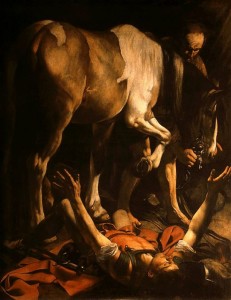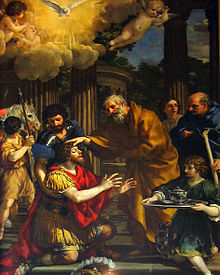You have heard, no doubt, of my earlier life in Judaism. I was violently persecuting the church of God and was trying to destroy it. I advanced in Judaism beyond many among my people of the same age, for I was far more zealous for the traditions of my ancestors. [Galatians 1:14-15, NRSV]
[L] Conversion of St Paul [detail] by Michelangelo. [M] Conversion of St Paul by Carravagio.. [R] Ananias Restoring the Sight of St. Paul (c.1631) by Pietro da Cortona.
The conversion of St Paul was as strange a story as you can possibly find anywhere. Today, when someone has a dramatic conversion it is often described as a ‘Damascus Road’ experience. It is a reference to an event testified in Scriptures.
As chapter 9 of the Acts of the Apostles tells it, a man named Saul, who was a strict Pharisee and an arch-persecutor of Christians, was on his way to Damascus when he was suddenly struck blind. He heard a voice calling: “Saul, Saul, why do you persecute me?” It turned out to be the voice of Christ, and thus the most dramatic conversion in Christian history came to be recorded.
Scriptures say it was a flash of light from heaven that caused him to fall to the ground. The single source of light magnifies the drama of the moment of Saul embracing the True Light of Christ, piercing through the darkness of his ill-conceived conviction. However, as the story unfolds, though Paul is physically blinded, he finally has interior light. The question is, what do you do once you have received the light and can “see”? Thich Nhat Hanh’s insight regarding sight offers us an incisive answer: “Once there is seeing, there must be acting. Otherwise, what is the use of seeing?”
So Saul became a follower of Christ, changed his name to Paul, and went on to become a great apostle and teacher. Without his many extant letters, the New Testament would really be quite different. An arch-persecutor has turned “traitor” to his own faith and become a believer in Christ. It was all but an impossible conversion.
From that conversion experience, Paul’s direction in life took a complete reversal. Previously, persecuting Christians, Paul was doing what he wanted to do. Now, preaching the Gospel of Jesus Christ, Paul turned to doing what God wanted him to do. Paul went on to become the foremost missionary, evangelizer and preacher in Christian history, earning him the title Apostle to the Gentles.
At the root of Paul’s teaching is real metanoia, a new mode of existence, and a new identity. Paul offers a spectacular example of someone who encountered Jesus and allowed that experience to radically transform his life. Once he was convinced of Christ’s message, Paul was willing to give everything he had.
- “For him I have accepted the loss of everything, and I look on everything as so much rubbish if only I can have Christ and be given a place in him.” [Phil 3:8b]
Determined and ready to endure sufferings for the Gospel, he thereby became credible as teacher of truth. Now, we repeatedly hear in Pope Francis’ preaching that men and women today need that personal encounter with the Lord, which will open to them the doors of an existence enlightened by the grace and love of God.
Paul’s conversion has been of such crucial significance that the Church celebrates it as a feast day on January 25. As we celebrate the feast in and with the Body of Christ, we know that we cannot just assume that people will do what the Bible says. The question really is can we assume that we will?
- What is the fundamental focus in our own lives? Is it the will of God, or things we want to do?
- What are we willing to give in order that our lives will be as consumed by the Gospel message as Paul was? Why do we hold back our 3T’s – time, talents, treasures – in service of the Kingdom?
Paul’s conversion has also been a popular theme for artists through the ages. While Michelangelo, for example, had him depicted as an elderly man with a beard, Carravagio portrayed him as a much younger man and is closer to his age at the time. In both cases, as in many other artists’ works, Paul is shown falling off a horse, although actually Scriptures do not specify that this actually happened.
A great preacher, St Paul had strong things to say about Christians who failed to live by the truth or who adopt lazy or immoral lifestyles. He allowed no compromise on discipline and morality. He likewise made no apology for insisting that Christianity is life-changing and crucial. Christ is never an optional extra, or some kind of appendage to the edges of our other, busy, lives.
Christian homes and schools can profitably celebrate this feast, putting the following ideas, amongst others, to good use:
- Open the Bible and search the different accounts of St Paul’s conversion;
- The scriptural account is a dramatic one that can be acted out or read aloud by children playing different roles and taking different voices. The part involving Ananias adds to the intense drama.
- The celebration of the feast can also be a frame in which the life of St Paul can be taught and its meaning and purpose explored.
Copyright © Dr. Jeffrey & Angie Goh, January 2015. All rights reserved.
You are most welcome to respond to this post. Email your comments to jeffangiegoh@gmail.com. You can also be dialogue partners in this Ephphatha Coffee-Corner Ministry by sending us questions for discussion.

![Conversion of St Paul. Michelangelo [detail]](http://www.jeffangiegoh.com/wp-content/uploads/2015/01/Conversion-of-St-Paul.-Michelangelo-detail.jpg)

